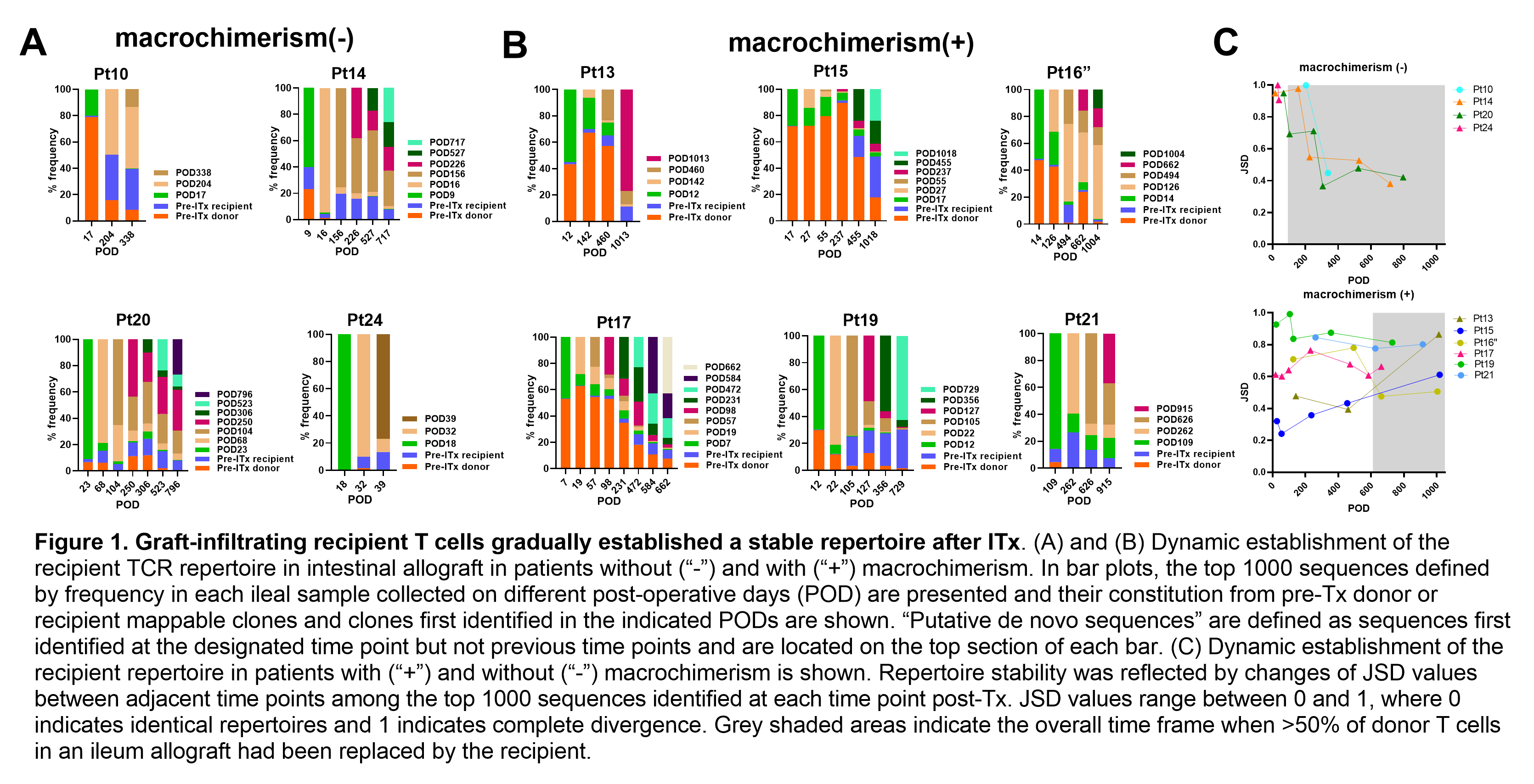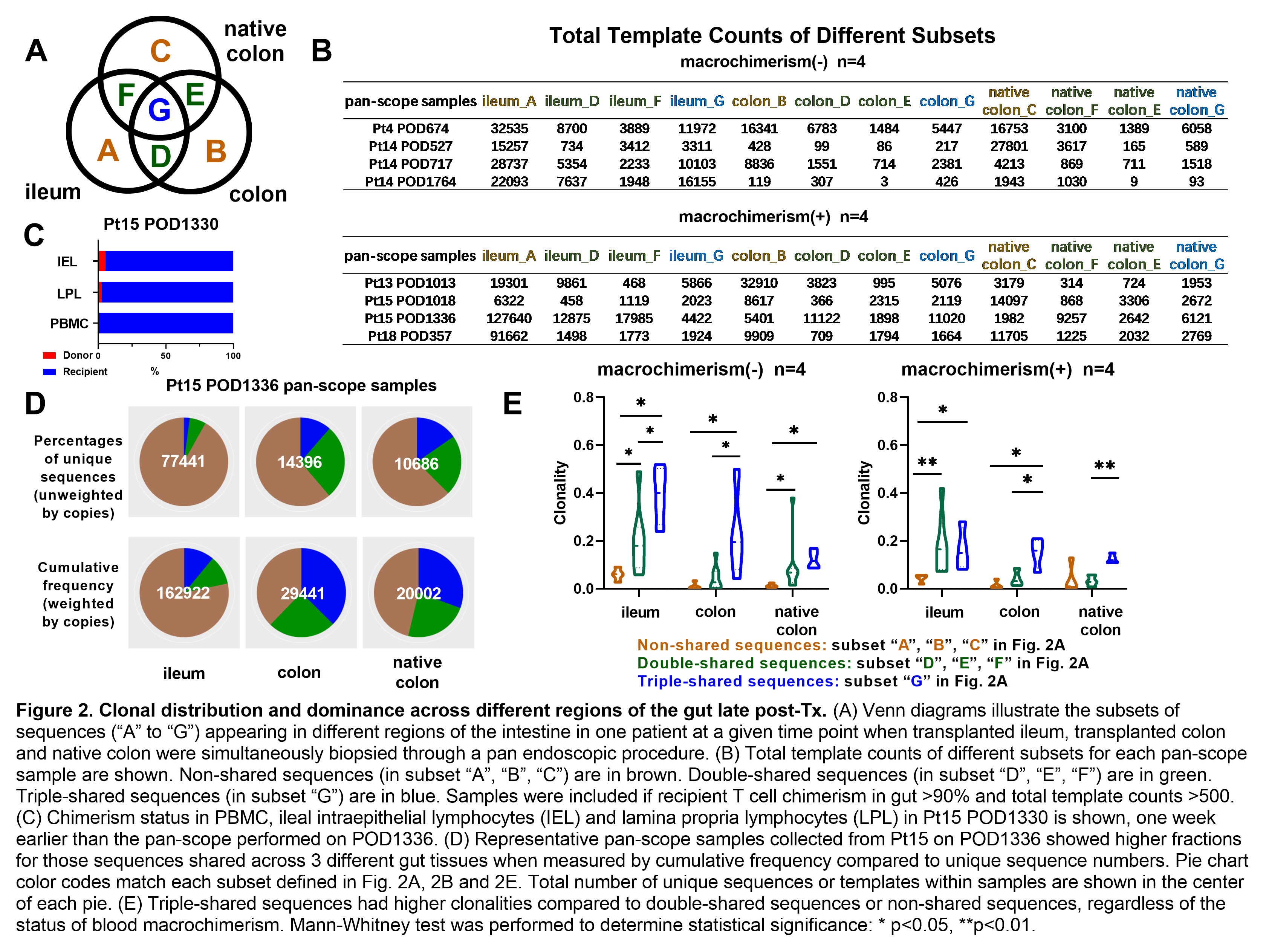Dynamic Reconstitution of Recipient Resident Memory T Cell Repertoire After Human Intestinal Transplantation
W. Jiao, M. Martinez, J. Zuber, A. Obradovic, R. Jones, E. Waffarn, Z. Wang, A. Gorur, K. Rogers, T. Kato, Y. Shen, J. Fu, M. Sykes
Columbia University, New York, NY
Meeting: 2021 American Transplant Congress
Abstract number: 1245
Keywords: Graft-infiltrating lymphocytes, T cell graft infiltration
Topic: Clinical Science » Small Bowel » Intestinal Transplantation and Rehabilitation
Session Information
Session Name: Intestinal Transplantation and Rehabilitation
Session Type: Poster Abstract
Session Date & Time: None. Available on demand.
Location: Virtual
*Purpose: Our studies in intestinal transplant (ITx) recipients demonstrated that donor T cell blood macrochimerism(peak level ≥4%) is associated with slower graft T cell replacement by the recipient and less rejection. Graft-infiltrating recipient T cells gradually take on the resident memory (TRM) phenotype during quiescence. However, TRM repertoire formation under quiescent and rejection conditions is largely unexplored.
*Methods: We have investigated the dynamics of T cell receptor (TCR) repertoire reconstitution by recipient T cells in intestinal allografts across time and space by applying TCR sequencing and flow cytometry from pre-Tx recipient lymphoid tissue and post-Tx gut and blood over years.
*Results: In ileal allografts, cumulative percentages of TCRs identified in earlier graft biopsies increased over time, demonstrating the establishment of a stable recipient repertoire (Fig. 1). Establishment of a stable repertoire appeared more rapid in patients without blood macrochimerism, as 4 out 4 showed an overall decline in jensen-shannon divergence (JSD) values between adjacent times in ileum within 400 days. In contrast, 5 out 6 patients with blood macrochimerism and long-term follow up showed delayed establishment of a stable repertoire, as reflected by either an increased or a stable trend of JSD values. Low JSD values in Pts 15 and 13 early post-Tx reflected persistent donor TRM repertoires and JSDs increased as recipient cells eventually replaced those of the donor. The delay in recipient replacement of donor TRM resulted in a delay in the establishment of a stable recipient repertoire. Recipient sequences were shared across different gut tissues and these demonstrated higher clonal dominance and lower diversity compared to those appearing in only one gut region, indicating that dominant recipient-derived TRM T cell clones seeded the entire gut, including the native colon (Fig. 2).
*Conclusions: Our data reveal the dynamic establishment of a stable TRM repertoire over time after ITx by recipient T cells across different regions of the gut. This process is more rapid in patients without blood macrochimerism, who are also more prone to rejection.
To cite this abstract in AMA style:
Jiao W, Martinez M, Zuber J, Obradovic A, Jones R, Waffarn E, Wang Z, Gorur A, Rogers K, Kato T, Shen Y, Fu J, Sykes M. Dynamic Reconstitution of Recipient Resident Memory T Cell Repertoire After Human Intestinal Transplantation [abstract]. Am J Transplant. 2021; 21 (suppl 3). https://atcmeetingabstracts.com/abstract/dynamic-reconstitution-of-recipient-resident-memory-t-cell-repertoire-after-human-intestinal-transplantation/. Accessed December 18, 2025.« Back to 2021 American Transplant Congress


